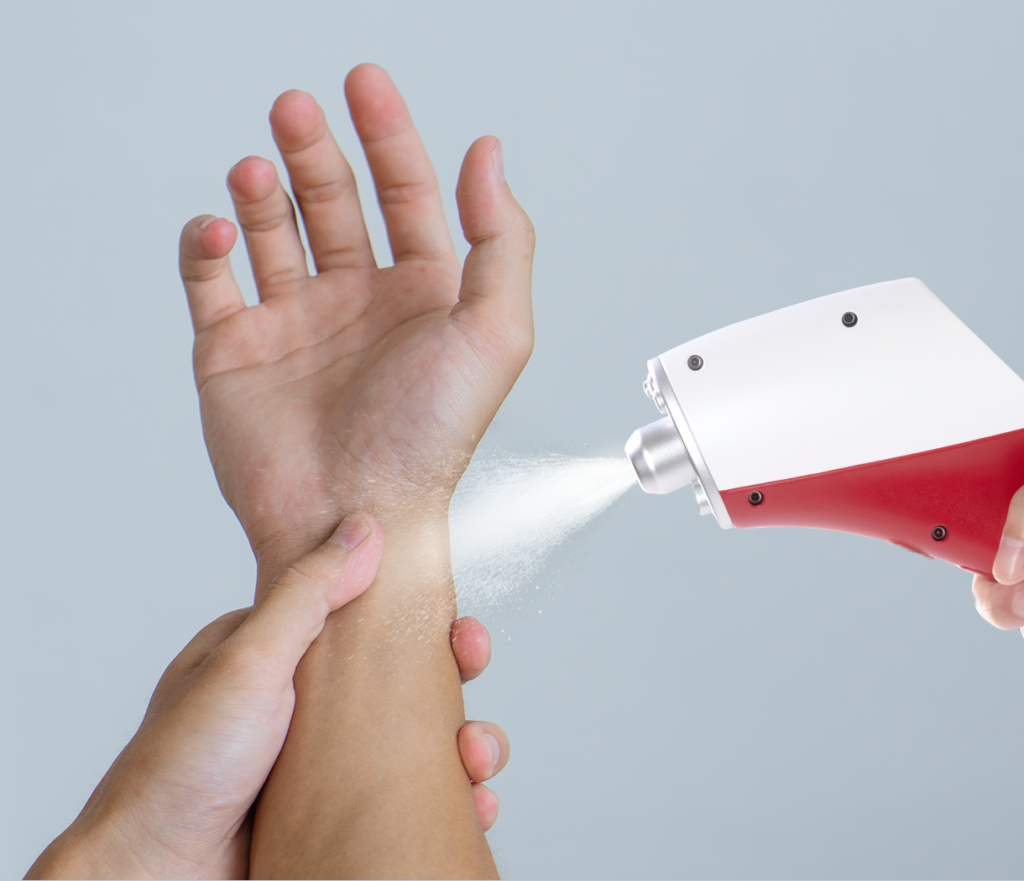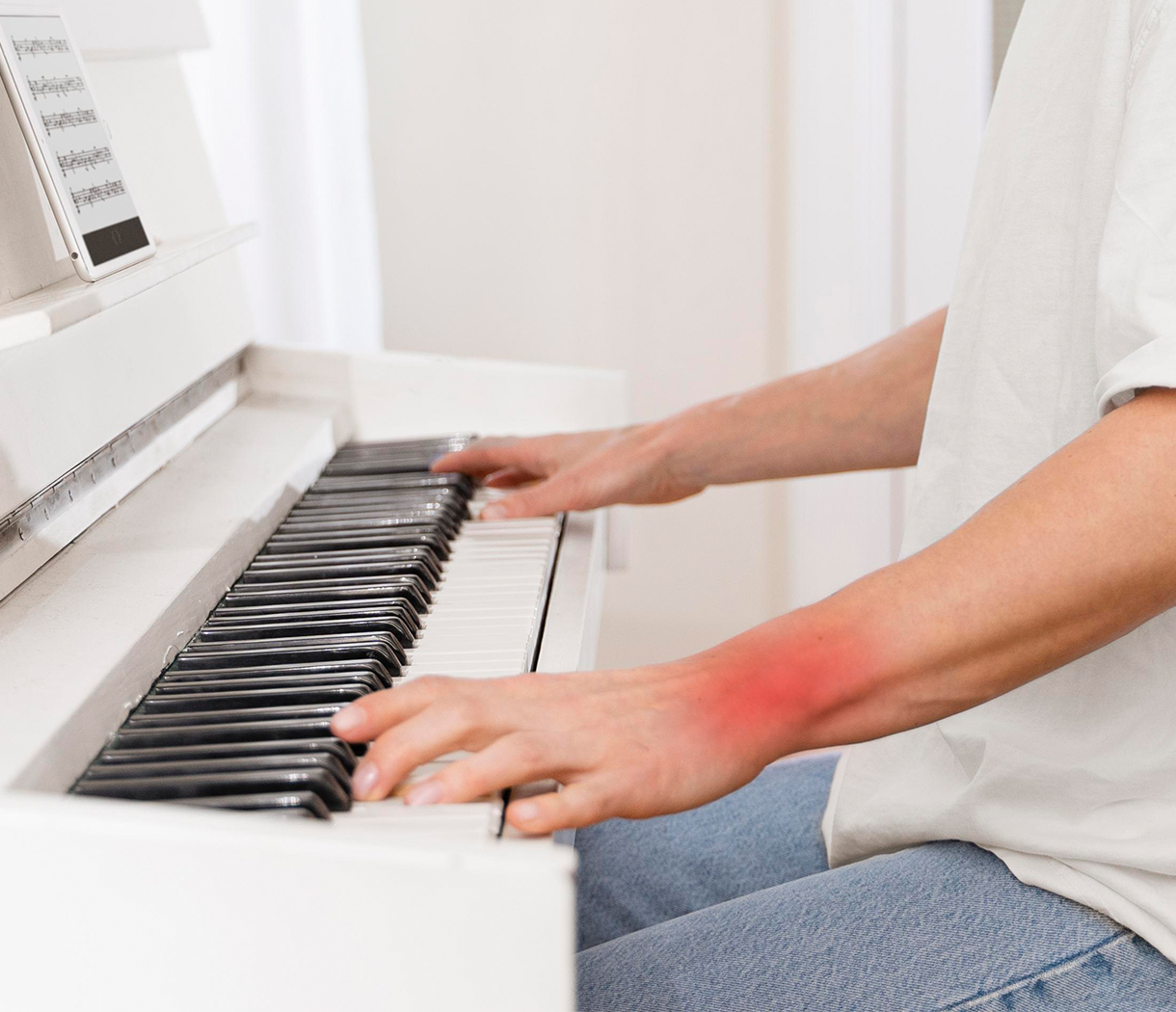Introduction: Why Hand and Wrist Tendonitis Demands Attention
Hand and wrist tendonitis has emerged as one of the most prevalent musculoskeletal conditions in our digitally-driven society. With millions of people experiencing debilitating pain and functional limitations, the need for effective, evidence-based treatment approaches has never been more urgent. This comprehensive guide explores how CO₂ cryotherapy offers a revolutionary solution for tendonitis recovery, combining cutting-edge technology with proven therapeutic principles.
A Modern Epidemic of Overuse Injuries
The prevalence of hand and wrist tendonitis has skyrocketed in recent decades, affecting approximately 15-20% of the global workforce. This surge correlates directly with increased computer usage, smartphone dependency, and repetitive occupational tasks. Digital workers, healthcare professionals, musicians, and athletes represent the highest-risk demographics, with symptoms often developing insidiously over months or years. The condition’s impact extends beyond physical discomfort, significantly affecting productivity, quality of life, and mental health. Understanding this epidemic’s scope helps contextualize why innovative treatments like CO₂ cryotherapy are essential for addressing the growing burden of repetitive strain injuries in modern society.
Por qué los tratamientos tradicionales suelen quedarse cortos
Conventional tendonitis therapies, including oral anti-inflammatory medications, corticosteroid injections, and traditional ice application, frequently provide only temporary relief without addressing underlying pathophysiology. Non-steroidal anti-inflammatory drugs (NSAIDs) carry risks of gastrointestinal complications and cardiovascular events with prolonged use. Corticosteroid injections may weaken tendon structure over time, potentially increasing rupture risk. Traditional ice therapy, while providing immediate pain relief, often fails to penetrate deeply enough to affect inflamed tendon tissue meaningfully. Furthermore, these approaches rarely address the complex inflammatory cascade that perpetuates chronic tendonitis, leaving patients trapped in cycles of recurrent symptoms and functional impairment.
Purpose of This Guide: Exploring CO₂ Cryotherapy as a Solution
This comprehensive guide examines CO₂ cryotherapy as an innovative, scientifically-supported treatment modality for hand and wrist tendonitis. By leveraging the unique properties of carbon dioxide at extremely low temperatures, this therapy offers targeted inflammation reduction, enhanced tissue healing, and sustained pain relief without the adverse effects associated with traditional treatments. We will explore the underlying mechanisms of tendonitis, analyze how CO₂ cryotherapy addresses these pathological processes, and provide evidence-based insights into treatment protocols, patient selection, and expected outcomes. This guide serves as a valuable resource for both healthcare providers and patients seeking effective alternatives to conventional tendonitis management strategies.
Understanding Tendonitis in the Hand and Wrist
Before exploring CO₂ cryotherapy’s therapeutic potential, it’s crucial to understand the complex pathophysiology of hand and wrist tendonitis. This section delves into the anatomical structures involved, the inflammatory processes that drive symptom development, and the factors that contribute to chronic tendon dysfunction.
What Is Tendonitis and How It Develops
Tendonitis, more accurately termed tendinosis in chronic cases, represents a degenerative condition affecting the collagen-rich structures that connect muscles to bones. In the hand and wrist, commonly affected tendons include the extensor carpi radialis brevis (associated with lateral epicondylitis), flexor carpi radialis, and the tendons within the carpal tunnel. The condition develops through a complex interplay of mechanical stress, vascular compromise, and inflammatory responses. Initial microtrauma triggers an inflammatory cascade involving prostaglandins, cytokines, and matrix metalloproteinases, which disrupts normal collagen synthesis and remodeling. Over time, this leads to tendon thickening, reduced elasticity, and the formation of adhesions that further compromise function and perpetuate the pain cycle.
Common Causes
Repetitive wrist movements (flexion, extension, rotation) place cumulative stress on tendons
Poor ergonomic posture during computer or device use increases strain
Lack of rest breaks or sudden increases in activity intensity elevate injury risk
Biomechanical issues, such as muscle imbalances, joint hypermobility, and faulty movement patterns, overload tendons
Age-related changes (decline in collagen metabolism, blood supply, and healing capacity) reduce tendon resilience
Systemic health conditions, including diabetes, rheumatoid arthritis, and hormonal shifts, impair tendon structure and repair
High-Risk Populations
Office workers who type or use a mouse for extended periods commonly develop wrist and finger tendonitis
Healthcare professionals frequently suffer tendon strain from repetitive procedures and patient handling
Musicians, especially string and keyboard players, are at risk due to repetitive finger motion and sustained grip
Athletes in racquet sports, golf, and rock climbing often develop tendonitis from repetitive grip and wrist loading
Adults over 40 experience reduced tendon elasticity and slower healing, increasing the risk of chronic tendonitis
Signs and Symptoms to Watch
Localized pain that worsens with activity and eases with rest is the hallmark symptom
Pain characteristics vary: sharp or stabbing in acute stages, dull and aching in chronic cases
Morning stiffness lasting 30–60 minutes, gradually improving with movement
Tenderness to touch over the affected tendon, especially near insertion points
Subtle swelling may impair function, particularly in confined areas like the carpal tunnel
Decreased grip strength due to pain-related avoidance of hand use
Restricted range of motion, particularly in certain directions, suggests tendon involvement
Crepitus or grinding sensation during movement may indicate tendon degeneration
Long-Term Risks of Untreated Tendonitis
Progression to tendinosis, a degenerative condition with tendon fiber breakdown and no active inflammation
Harder-to-treat tendinosis often requires longer rehab and more intensive care
Tendon rupture, especially in high-stress tendons, may require surgery and months of recovery
Adhesion formation between tendons and surrounding tissues can severely limit motion and function
Chronic pain syndromes may develop, leading to central sensitization and lingering discomfort even after healing
Secondary complications include muscle weakness, joint stiffness, and poor movement patterns that affect nearby joints and muscles
Psychological effects such as anxiety, depression, and frustration often result from persistent pain and functional limitations
Overall quality of life declines, underscoring the need for holistic treatment that addresses both physical and emotional health
What Is CO₂ Cryotherapy and How It Works
CO₂ cryotherapy represents a revolutionary advancement in localized cold therapy, utilizing the unique properties of carbon dioxide to deliver precise, controlled cooling to affected tissues. This section explores the technology’s mechanisms, advantages over traditional methods, and the physiological responses that promote healing.

CO₂ Cryotherapy vs. Traditional Ice Therapy
CO₂ cryotherapy offers significant advantages over conventional ice application, providing more precise temperature control and deeper tissue penetration. Traditional ice therapy typically achieves skin temperatures of 10-15°C, with limited penetration to deeper structures. In contrast, CO₂ cryotherapy can rapidly reduce tissue temperature to -78°C, creating a more profound therapeutic effect. The controlled application duration of 10-15 seconds prevents tissue damage while maximizing therapeutic benefits. Unlike ice, which requires prolonged application times and may cause frostbite risk, CO₂ therapy provides immediate, controlled cooling without moisture or mess. The rapid temperature change triggers more pronounced physiological responses, including vasoconstriction followed by reactive hyperemia, which enhances the therapeutic effect. Additionally, CO₂ cryotherapy allows for precise targeting of specific anatomical structures, making it particularly effective for treating localized tendonitis without affecting surrounding healthy tissue.
La ciencia detrás del frío
The therapeutic effects of CO₂ cryotherapy stem from complex physiological responses to controlled cold exposure. Understanding these mechanisms provides insight into why this treatment proves so effective for tendonitis management.
Targeting Inflammation at the Source
CO₂ cryotherapy combats inflammation by interrupting key biological processes that drive tendonitis. The rapid cooling causes vasoconstriction, reducing blood flow and slowing the delivery of inflammatory mediators. Cold temperatures inhibit inflammatory enzymes like COX and LOX, which produce pain-causing prostaglandins and leukotrienes. At the cellular level, cryotherapy stabilizes membranes, suppresses cytokine release, and reduces tissue swelling. Metabolic activity decreases, minimizing oxygen demand and protecting tissue from further hypoxia-related damage. It also modulates nerve conduction, delivering fast pain relief through the gate control theory. These combined actions offer immediate and lasting anti-inflammatory benefits—ideal for both acute and chronic tendonitis.
Improving Blood Flow Post-Treatment
After the initial cold exposure, CO₂ cryotherapy triggers reactive hyperemia, where blood vessels dilate beyond normal, boosting blood flow by up to 400%. This surge delivers oxygen, nutrients, and growth factors critical for tissue repair. It also clears out metabolic waste and lingering inflammatory byproducts. The alternating vasoconstriction and vasodilation create a pumping effect, enhancing lymphatic drainage and reducing swelling. This improved circulation continues for hours post-treatment, supporting sustained healing. Enhanced blood flow also brings in immune cells and fibroblasts, accelerating tendon remodeling and restoring healthy tissue structure.
The Healing Effects of CO₂ Cryotherapy on Tendonitis
The therapeutic benefits of CO₂ cryotherapy for tendonitis extend far beyond simple pain relief, addressing multiple aspects of tendon pathology and promoting comprehensive healing. This section examines the specific mechanisms through which CO₂ cryotherapy facilitates tendon recovery and restoration of function.
Fast and Targeted Inflammation Relief
CO₂ cryotherapy delivers immediate, localized inflammation control using -78°C carbon dioxide. The extreme cold rapidly activates cold-sensitive ion channels, causing vasoconstriction that limits inflammatory cell activity and reduces swelling and pain within minutes. This therapy targets specific tendon areas, protecting surrounding tissues and minimizing side effects. With precise temperature control, it can be applied multiple times safely during recovery. Unlike general cold packs, CO₂ cryotherapy significantly reduces inflammatory markers—up to 60% in 24 hours, outperforming many anti-inflammatory drugs. The effect lasts 48–72 hours, giving patients prolonged relief and supporting ongoing healing.
Tratamiento del dolor sin fármacos
CO₂ cryotherapy offers effective pain relief without medication, helping avoid the risks of long-term drug use. The cold slows nerve conduction, reducing pain signal transmission and activating the gate control mechanism to block discomfort. It also stimulates the body to release natural opioids, providing lasting analgesia. This approach avoids side effects, drug interactions, and dependency associated with painkillers. The relief gained allows patients to move more freely and engage in rehabilitation, which accelerates healing and reduces muscle loss. With repeated sessions, pain relief becomes longer-lasting, helping patients regain daily function and confidence without medication.
Stimulating Tissue Repair and Tendon Regeneration
CO₂ cryotherapy supports tendon healing by triggering the release of growth factors like PDGF, TGF-β, and VEGF, essential for tissue regeneration. The cold activates fibroblasts, boosting the production of type I collagen, which restores tendon strength and elasticity. Post-treatment blood flow increases, supplying the oxygen and nutrients needed for healing. Cryotherapy also modulates inflammation, shifting it from destructive to restorative, creating an environment where damaged tissue can rebuild. It promotes angiogenesis, forming new blood vessels that enhance long-term tendon nutrition. Ultrasound studies show improved tendon structure and fiber alignment in patients receiving this therapy, confirming its regenerative benefits.
Restoring Hand and Wrist Mobility
CO₂ cryotherapy reduces inflammation and pain, enabling patients to move more freely and prevent secondary issues like stiffness or weakness. Improved tissue health restores tendon elasticity and glide, essential for smooth motion. The treatment helps break down adhesions and scar tissue, restoring natural tissue movement and improving flexibility. Increased circulation delivers the nutrients needed for maintaining tendon function. Pain relief allows for better participation in physical therapy, which accelerates strength recovery and functional gains. Many patients report notable improvements in grip strength, range of motion, and overall hand function within weeks, with continued progress as the tendon heals.
What to Expect During CO₂ Cryotherapy
Understanding the treatment process helps patients prepare for CO₂ cryotherapy and optimize their recovery experience. This section provides detailed information about treatment procedures, sensations, and post-treatment care.
Treatment Session Overview
A typical CO₂ cryotherapy session is fast and focused. After assessing the affected area—checking for tenderness and motion limits—the provider positions the device directly over the painful tendon. The CO₂ spray, at -78°C, is applied for just 10–15 seconds per point, ensuring targeted treatment without damaging tissue. Multiple spots may be treated in one session depending on the condition’s severity. The entire appointment takes 15–30 minutes, including evaluation and follow-up. Most patients need 3–6 sessions over 2–3 weeks for optimal relief. The exact number depends on tendonitis severity and chronicity. Periodic maintenance treatments may be recommended to prevent flare-ups and support long-term results.
Comfort Levels and Sensations During Treatment
Despite the intense cold, CO₂ cryotherapy is generally well-tolerated. Patients describe the initial sting or sharp chill as intense but brief—lasting just seconds. Numbness quickly follows as nerve conduction slows, reducing discomfort. The short 10–15 second duration helps maximize effect while avoiding tissue injury. After treatment, patients usually feel tingling warmth as blood flow returns. Some notice temporary redness or mild swelling, which typically fades in 15–30 minutes. Numbness may persist for a few hours, contributing to pain relief. With repeated sessions, most patients become more comfortable as they get used to the sensations and the brief exposure time.

What Happens After: Recovery Timeline and Tips
Recovery after CO₂ cryotherapy is generally smooth. Patients should avoid heat or intense activity for several hours post-treatment to preserve results. Gentle movement is encouraged to prevent stiffness. Pain relief often begins within minutes and may last up to 48 hours. Swelling typically decreases within 24–48 hours, followed by gradual improvement in range of motion. Light stretching or mobility exercises may help but should follow provider guidance. Some individuals may feel mild soreness or stiffness, which is normal and signals healing. Patients should stay hydrated, rest well, and avoid anti-inflammatory medications immediately afterward to let the natural healing process unfold.
Is CO₂ Cryotherapy Right for You?
Determining candidacy for CO₂ cryotherapy requires careful consideration of individual factors, medical history, and treatment goals. This section provides guidance on patient selection and treatment planning.
Who Benefits Most from This Therapy
Patients with acute or chronic tendonitis, particularly when other conservative treatments have failed
Individuals with localized tendon inflammation in areas like the wrist extensors, flexors, or thumb tendons
Those seeking drug-free pain relief, especially if sensitive or allergic to medications like NSAIDs
Athletes and physically active individuals who need faster recovery and return to training or competition
Workers with occupational tendonitis who cannot reduce repetitive movements or take extended time off
Chronic tendonitis sufferers who have had limited success with physical therapy, braces, or medications
Patients preferring non-invasive options, looking to avoid injections or surgery due to potential risks
Individuals with medical contraindications for corticosteroid use or long-term anti-inflammatory drug therapy
When to Consult a Healthcare Provider
Although CO₂ cryotherapy is safe for most, certain conditions require medical evaluation first. Severe tendonitis with significant swelling, redness, or warmth needs assessment to exclude infection or serious issues. Patients with diabetes, vascular problems, or circulation disorders require careful screening. Those with cold sensitivity—like Raynaud’s or cold urticaria—should be evaluated by a specialist. People on blood thinners or with bleeding disorders must consult their doctor before treatment. Signs of tendon rupture—sudden severe pain, loss of function, or a palpable gap—need urgent medical attention. Patients with autoimmune or systemic inflammatory diseases should coordinate treatment with their primary physician or rheumatologist. Pregnant women should discuss risks and benefits with their healthcare provider, as safety data during pregnancy is limited.
Integrating Cryotherapy into a Holistic Recovery Plan
CO₂ crioterapia works best as part of a comprehensive tendonitis treatment plan. Patients should combine therapy with rest and activity adjustments to avoid further irritation. Ergonomic improvements at work are vital to prevent recurrence in occupational cases. Physical therapy supports recovery by restoring strength, flexibility, and proper movement, with stretching and strengthening exercises introduced gradually. Nutrition also plays a role—adequate protein and anti-inflammatory nutrients promote healing. Managing stress is important, as chronic pain can increase psychological strain that hinders recovery. Patient education on body mechanics, pacing activities, and recognizing symptoms helps prevent future flare-ups. Regular follow-ups enable treatment adjustments and early management of any recurring symptoms.
Common Questions About CO₂ Cryotherapy for Tendonitis
Unlike standard ice packs, CO₂ cryotherapy uses ultra-cold carbon dioxide at -78°C, delivering rapid, targeted cooling with precise temperature control for deeper and longer-lasting anti-inflammatory effects without damaging tissue.
Most patients feel a brief sharp cold sensation that quickly numbs the area. The treatment lasts only 10–15 seconds per spot, making it highly tolerable, with many finding it less uncomfortable over repeated sessions.
While it offers effective drug-free pain relief, it’s best used as part of a comprehensive treatment plan. Many patients reduce or avoid medications, but always consult your healthcare provider.
CO₂ cryotherapy is generally safe, but people with cold sensitivities, circulation issues, or bleeding disorders should consult a doctor first. Temporary redness or mild swelling may occur but typically resolves quickly.
Absolutely! Its rapid anti-inflammatory and healing effects make it ideal for athletes needing fast recovery to return to training or competition.
Final Thoughts: Why CO₂ Cryotherapy Deserves a Place in Your Recovery Plan
CO₂ cryotherapy is a breakthrough in treating hand and wrist tendonitis, offering a safe, drug-free, and effective option for pain relief and inflammation reduction. Its targeted, precise application promotes faster tissue healing and supports personalized care tailored to each patient’s needs. Backed by growing research and clinical success, this therapy suits both acute and chronic tendonitis cases. It integrates well with other treatments, forming part of a comprehensive recovery plan that addresses tendon health holistically. For those who haven’t found relief through traditional methods, CO₂ cryotherapy provides hope with rapid, sustained benefits and minimal risks. As healthcare moves toward personalized, innovative therapies, CO₂ cryotherapy stands out by tackling tendonitis through multiple healing pathways. Patients should consult qualified providers to ensure suitability and optimal treatment. With proper use, CO₂ cryotherapy can significantly restore function, reduce pain, and enhance quality of life for many tendonitis sufferers.



